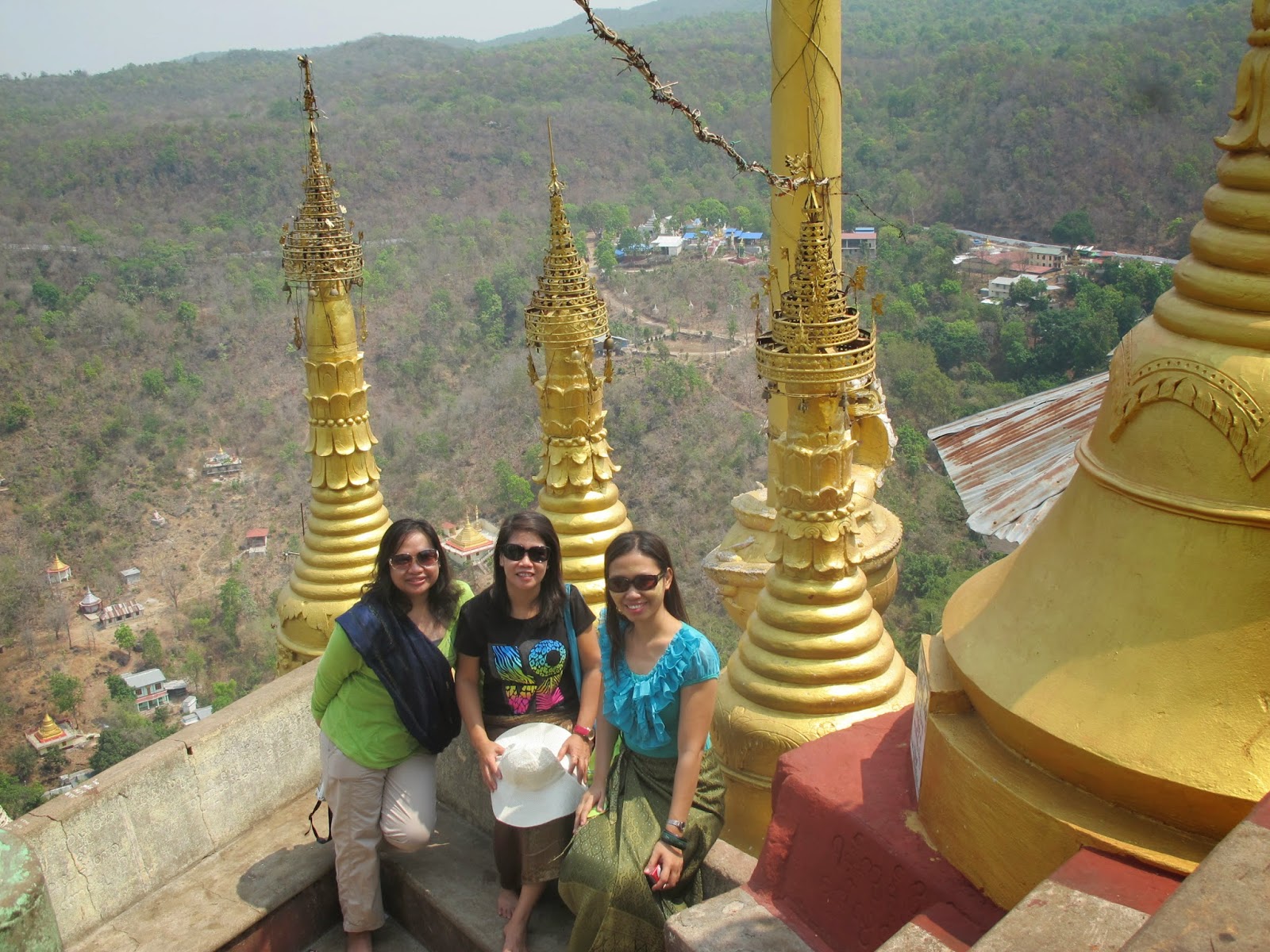Temple on top of the Pedestal Hill in Mt. Popa
After fininshing the 900 plus steps, the first 300 with shoes and the rest is the way to the temple consisitng of 777 steps in barefoot, I realised that it is not the grandeur of the golden temple atop the hill formation that should be the goal. There is nothing spectacular in the temple perched on top of this formation. I decided that the goal should be feeling one's feet on the ground with all the dirtiness in it, breathing in the warm crisp air, enjoying the view from the top and observing the Myanmarese doing their religious ritual on various temples stationed along the way.
***
Southwest of Mount Popa is Taung Kalat (pedestal hill), sheer-sided volcanic plug, which rises 737 metres (2,417 ft) above the sea level. A Buddhist monastery is located at the summit of Taung Kalat. At one time, the Buddhist hermit U Khandi maintained the stairway of 777 steps to the summit of Taung Kalat. The Taung Kalat pedestal hill is sometimes itself called Mount Popa and given that Mount Popa is the name of the actual volcano that caused the creation of the volcanic plug, to avoid confusion, the volcano (with its crater blown open on one side) is generally called Taung Ma-gyi (mother hill). The volcanic crater itself is a mile in diameter. (Wikipedia)
***
From the top of Taung Kalat one can enjoy a panoramic view. One can see the ancient city of Bagan; behind it to the north, the massive solitary conical peak of Taung Ma-gyi rises like Mount Fuji in Japan. There is a big caldera, 610 metres (2,000 ft) wide and 914 metres (3,000 ft) in depth so that from different directions the mountain takes different forms with more than one peak. The surrounding areas are arid, but the Mt Popa area has over 200 springs and streams. It is therefore likened to an oasis in the desert-like dry central zone of Burma. This means the surrounding landscape is characterized by prickly bushes and stunted trees as opposed to the lush forests and rivers Burma is famous for. Plenty of trees, flowering plants and herbs grow due to the fertile soil from the volcanic ash. Prominent among the fauna are Macaque monkeys that have become a tourist attraction on Taung Kalat. (Wikipedia)
***
Not to mention among the goal is that to, slowly accept the fact that monkeys are residents of the mountains and it was us who interfered with their environment. ... picturesque landscape along the way, fruits, flowers, monkeys, Mt. Popa, 777 steps (or more, they say), walking in barefoot, jars of water which serve as public fountain of drinking water...
***
***
***
Mount Popa is a volcano 1518 metres (4981 feet) above sea level, and located in central Burma (Myanmar) about 50 km (31 mi) southeast of Bagan (Pagan) in the Pegu Range. It can be seen from the Ayeyarwady (Irrawaddy) River as far away as 60 km (37 mi) in clear weather. Mount Popa is perhaps best known as a pilgrimage site, with numerous Nat temples and relic sites atop the mountain. (Wikipedia)
***
***
***
***
***
***
***
Many legends are associated with this mountain including its dubious creation from a great earthquake and the mountain erupted out of the ground in 442 B.C.[4] It is possible that the legends about Nats represent a heritage of earlier animist religions in Burmese countryside, which were syncreticised with Buddhist religion in 11th century. There are legends that before the reign of Bagan king Anawrahta (1044 - 1077) hundreds of animals were sacrificed here as a part of nat worship rituals. Mount Popa is considered the abode of Burma's most powerful Nats and as such is the most important nat worship center. It has therefore been called Burma's Mount Olympus.
***
One legend tells about brother and sister Mahagiri (Great Mountain) nats, from the kingdom of Tagaung at the upper reaches of the Irrawaddy, who sought refuge from King Thinligyaung of Bagan (344-387). Their wish was granted and they were enshrined on Mt Popa. Another legend tells about Popa Medaw (Royal Mother of Popa), who according to legend was a flower-eating ogress called Me Wunna, she lived at Popa. She fell in love with Byatta, whose royal duty was to gather flowers from Popa for King Anawrahta of Bagan (1044–1077). Byatta was executed for disobeying the king who disapproved of the liaison, and their sons were later taken away to the palace. Me Wunna died of a broken heart and, like Byatta, became a nat. Their sons also became heroes in the king's service but were later executed for neglecting their duty during the construction of a pagoda at Taungbyone near Mandalay. They too became powerful nats but they remained in Taungbyone where a major festival is held annually in the month of Wagaung (August). Although all 37 Nats of the official pantheon are represented at the shrine on Mt Popa, in fact only four of them - the Mahagiri nats, Byatta and Me Wunna - have their abode here.
***


















Comments
Post a Comment